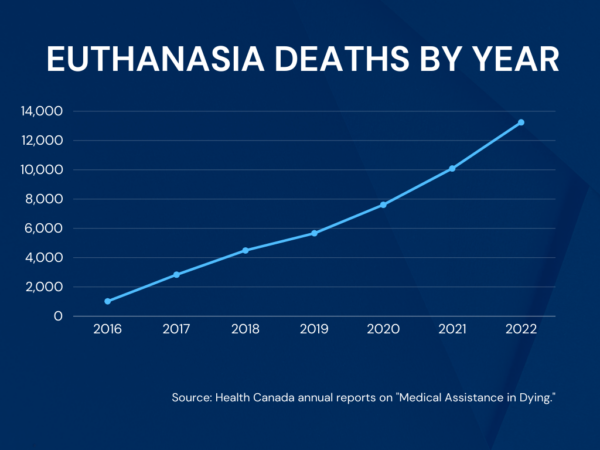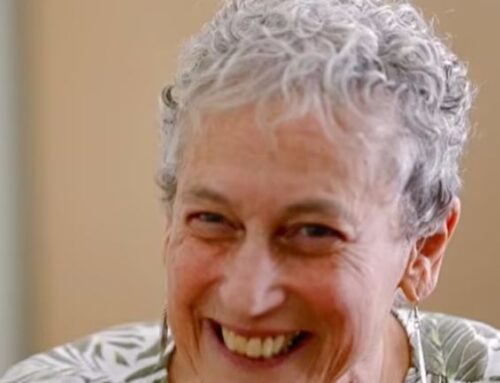Paul Tuns:
 Health Canada released the Fourth Annual Report on Medical Assistance in Dying (2022), with data showing that there were 13,241 assisted deaths in Canada, the seventh consecutive year of increased euthanasia deaths, representing 3.3 per cent of all deaths in the country.
Health Canada released the Fourth Annual Report on Medical Assistance in Dying (2022), with data showing that there were 13,241 assisted deaths in Canada, the seventh consecutive year of increased euthanasia deaths, representing 3.3 per cent of all deaths in the country.
Amanda Achtman, an anti-euthanasia activist, tweeted, “An average of 36 people are now being euthanized every single day in Canada. Based on the Government’s own data, it seems that Canadian euthanasia deaths since 2016 have now exceeded the total number of Canadian deaths to date from Covid.”
Before the report was released, Alex Schadenberg, executive director of the Euthanasia Prevention Coalition, estimated there would be approximately 13,200 assisted deaths in Canada. He was off by just 41 euthanasia deaths.
In 2016, the first year of legal euthanasia in Canada, there were 1018 assisted deaths, followed by 2838 in 2017, 4493 in 2018, 5665 in 2019, 7611 in 2020, and 10,092 in 2021. From legalization in 2016 to Dec. 31, 2022, there has been a total of 44,958 reported euthanasia deaths in Canada.
The number of euthanasia deaths increased by 31.2 per cent in 2022 compared to the year before.
Few MAiD deaths are physician-assisted suicides, with most patients opting for euthanasia in which a medical professional directly administers the lethal dose rather than merely prescribes it for the patient to take it on his or her own. The report states, “There were fewer than seven deaths from self-administered MAiD in 2022 across Canada, a trend consistent with previous years.”
Euthanasia deaths comprised 6.6 per cent of all deaths in Quebec and 5.5 per cent of all deaths in British Columbia. In Newfoundland and Labrador, medically assisted murders represent 1.5 per cent of all deaths and 1.8 per cent in Manitoba.
Bill C-7, which allows people whose natural deaths were not reasonably foreseeable to access physician-assisted suicide, took effect on March 2021. There were 463 euthanasia deaths in 2022 committed on people whose deaths were not imminent, 3.5 per cent of all cases.
The number of euthanasia requests grew by about a quarter, from 12,286 in 2021 to 16,104 in 2022. More than four in five euthanasia requests – 81.4 per cent – resulted in a reported MAiD death. Of the 3002 requests that resulted in an outcome other than a medically assisted killing, 298 withdrew their request (1.9 per cent), 560 were deemed ineligible (3.5 per cent), and 2144 died prior to the euthanasia request being fulfilled (13.3 per cent).
The average age of patients at the time they were killed was 77 years, but 1.3 per cent were between the ages of 18-45 and 3.2 per cent were between the ages of 46-55. About the same number of men and women are being killed by euthanasia (51.4 per cent are men), although women are significantly more likely than men to be euthanized when natural death is not imminent (59 per cent).
The most cited underlying medical condition for those requesting MAiD is cancer (63 per cent) followed by cardiovascular conditions (18.8 per cent), respiratory conditions (13.2 per cent), and neurological conditions (12.6 per cent). Other conditions accounted for 14.9 per cent of underlying medical condition.
The report noted nine in ten patients whose underlying condition when requesting euthanasia was cancer had no discussion with an oncologist about being euthanized.
Among those whose deaths were not imminent neurological conditions were reported as the underlying cause in fully half of the cases while nearly a quarter were for patients multiple comorbidities.
Schadenberg said, “It is concerning that only 3.5 per cent of the written requests were deemed ineligible,” noting that both “The Netherlands and Belgium have higher rates of people deemed ineligible.”
The three main reasons for requesting euthanasia was the “loss of ability to engage in meaningful activities” (86.3 per cent), “loss of ability to perform activities of daily living” (81.9 per cent) and “inadequate control of pain or concern about controlling pain” (59.2 per cent).
Achtman said that patients choosing euthanasia because of a loss of engagement in meaningful activities “confirms that euthanasia is mainly as existential issue, not a pain-management or medical one.”
Schadenberg said that more than 80 per cent of those requesting euthanasia were “receiving palliative care” but “Being enrolled in palliative care and receiving palliative care are different.” He said Canada needs a “to determine how many people who died by euthanasia were actually receiving palliative care.”
More than a third of euthanasia requests listed, “Perceived burden on family, friends or caregivers” as a rationale for requested MAiD (35.3 per cent), although nearly half of all requests in Quebec (47 per cent) listed being a burden as a reason for wanting to be killed by a medical professional.
There were a total of 568 euthanasia requests from patients who needed disability support services but were not receiving them.
About one in seven people who died by euthanasia requested being killed because of loneliness or feelings of isolation (17.1 per cent).
Schadenberg said, “Social isolation and loneliness require a compassionate caring community, not death by lethal injection.”
Schadenberg said that that data shows “Canada has quickly become the most permissive euthanasia regime in the world.”
According to the report, the number of “MAiD providers” increased by nearly a fifth between 2021 and 2022, with a total of 1837 physicians and nurse practitioners carrying out medical murders with fully two thirds (67.7 per cent) being family physicians. The average number of “MAiD provisions per practitioner” also increased from 6.5 in 2021 to 7.2 in 2022.




